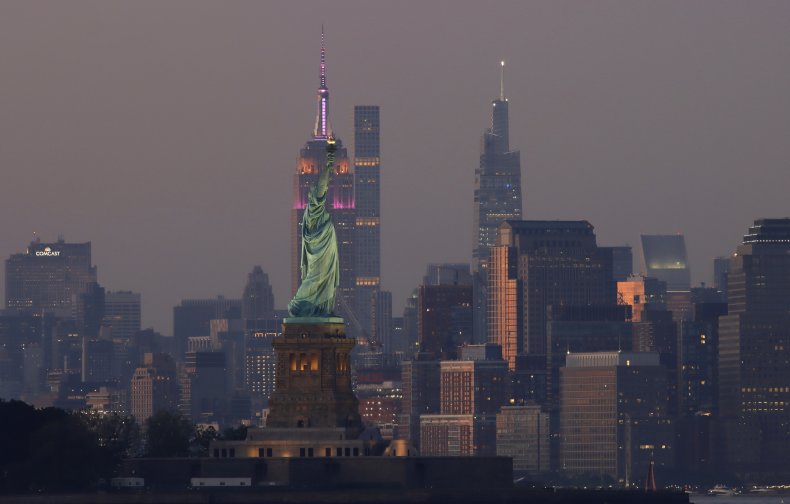[ad_1]
Mayor Eric Adam’s first State of the City address made it clear that infrastructure is a top priority. He announced the $904 million NYC Streets Plan initiative over five years, which included money for infrastructure—though without explicit budget details. The plan’s goal is to keep existing infrastructure up-to-date and properly maintained. Meeting that goal is ideal, as New Yorkers’ common and justified complaint is the city’s crumbling infrastructure. And progress is undoubtedly underway, including the construction of thousands of square feet of much-needed housing. Many existing structures in New York City demand urgent infrastructural attention, which, in some cases, means that ignoring the pressing needs of these structures will cost the lives of many New Yorkers.
One concerning example is the support pillars over the Trans-Manhattan Expressway. Video evidence shows their bases essentially deteriorating. These pillars support four apartment towers housing thousands of Bronx residents above a highway where 280,000 vehicles traverse between New York and New Jersey daily. Port Authority is aware of these concerning structural issues and said it is in the process of repairing them through the $2 billion Restoring the George program. Nevertheless, just because the city is aware of problems and has plans to fix them does not necessarily mean that actual progress is underway. In the 2021 Infrastructure Report Card by the American Society of Civil Engineers, New York state earned a C-. Having 9.9 percent of its bridges rated as “structurally deficient” does not help.
Cases similar to the Trans-Manhattan Expressway have already cost the lives of New Yorkers. For instance, the Bronx fire caused by an electrical space heater in January killed 19 people—including nine children—and injured 44 others, which lawyers claim happened due to negligence from the city and landlords. The faulty electrical wiring of similar buildings which set ablaze has been public knowledge since 1977, when the New York Daily News reported that “electrical defects are considered especially serious violations of thousands of codes. A minor flaw may cause a fire that endangers the lives of municipal residents; a small defect can make even a modern ‘fireproof’ building uninhabitable.”
Several other buildings were involved in this report, including Schomburg Plaza, a 35-story high-rise apartment building in Harlem that set ablaze in March 1987, killing seven residents—three jumping to their death while four burned to death. Given that the U.S. Fire Administration determined that these code violations may have contributed to this deadly fire, someone should be held accountable for impending infrastructural degradation that cause death due to decades-long negligence.
Mayor Adams’ message to New Yorkers in response to the recent Bronx tragedy blamed them for the fire and was tantamount to “forget about it,” urging us to “close the door,” raising eyebrows and questions.

Gary Hershorn/Getty Images
Long-term studies of New York City infrastructure by the Center for an Urban Future noted that some problems that need addressing are being fixed. Still, a considerable number of structures like bridges and buildings—disproportionately in the Bronx—are progressively worsening. Some of the data collected from these studies are startling.
“The number of bridges that are also fracture critical—at risk of partial collapse—jumped from 47 in 2012 to at least 67 in 2018,” the report stated. Who’s to say how long the pillars at the Trans-Manhattan Expressway can last in their currently degraded condition? If Mayor Adams holds to his promise to invest in New York City’s infrastructure, he must prioritize fixing the sorts of problems that needlessly cost lives when neglected and holding the negligent accountable.
Should continued infrastructural degradation without resolution be expected for most New York City residents? Ought victim-blaming and calls for collective amnesia be what New Yorkers come to expect from its political leaders in the face of future tragedies? Should people have to fear for their lives apropos of nothing other than living in New York City? Clearly not, so the prime challenge for Mayor Adams is ensuring that these expectations and fears become unwarranted. But that is yet to be seen, and it is unclear whether Adams will positively meet the challenge or crumble under pressure—quite like the Trans-Manhattan Expressway right now.
Daniel Lehewych has an MA in philosophy from the CUNY Graduate Center, specializing in moral psychology, cognitive science and the philosophy of mind. In addition to contributing to Newsweek, Daniel is a contributing writer for Big Think and Allwork.Space.
The views expressed in this article are the writer’s own
[ad_2]
Source link








